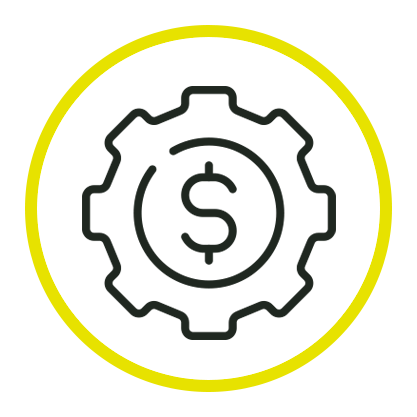Market Viability
The green economy includes a broad array of goods, processes, and services related to renewable energy, energy efficiency, sustainable construction and transportation, optimized resource consumption, minimized waste, and more—most of which are still considered “emerging” or “new” to the market.

The viability of these green products and services has to date been strongly influenced by private- and public-sector investments. These investments occur at the global, federal, state, and local levels and serve to balance the risks of adopting these "new" products as they reach a tipping point of viability marked by technological feasibility, affordability, and market acceptance.
Training programs are often treated as services—either to employers in need of skilled workers or to learners in need of specific skills. But spending on training can also be seen as a calculated risk because it means investing in emerging skills and technologies that may not have reached market viability.
When planning their future offerings, training and education programs are wisely tracking trends in national, state, and local priorities and viewpoints to determine whether to invest in green training, and if so what types of green training to prioritize in the near and long terms.
Most program leaders actively monitor trends that may not be workforce-specific but have meaningful workforce implications. Here are some examples of the types of trends they watch and where they get their data:
-
Investment Shifts
Program leaders follow news on public and private investments in various companies or technologies to gain insights into the possible future direction of industries that might impact the employment options of learners who complete their programs.
- For example, in 2024, global investments in green technologies decreased, including venture capital and private equity investments. Meanwhile investments in U.S. climate tech startups held steady, in large part due to policy initiatives such as the Inflation Reduction Act (IRA).1 Data like this can help program leads understand the various factors impacting the stability of an industry on both a macro and micro scale.
- Data on investment trends is available through resources such as Grants.gov, the Clean Investment Monitor, and the Big Green Machine.
-
Sales Figures
Program leaders follow news on how industries are faring not only locally but also nationally and globally, perhaps with an eye toward understanding how their region’s role in a global supply chain may be impacted by developments elsewhere.
- For example, 1.3 million electric vehicles (EV) were sold in 2024—accounting for around 8.7% of new car sales that year.2 That increase was driven in part by new governmental EV incentives, price cuts, and an increase in the number of EV models being released globally.3 This type of information would be valuable to training and education providers in regions where a significant number of people work for employers focused on activities like manufacturing EV batteries or maintaining EV charging stations.
- Sales data for industries that are part of the green economy is available through resources like the Short-term Energy Outlook (STEO) forecast from the U.S. Department of Energy; the U.S. Energy Information Administration, which offers state level data; and IEA’s Energy End-Uses and Efficiency Indicators database.
-
Policy Goals
Program leaders follow news on legislative, presidential, gubernatorial, and mayoral priorities that impact specific industries, in part to understand if there may be potential workforce funding aligned to those industries.
- For example, some states, including Vermont, are setting new goals for utilities to achieve 100% clean energy usage by a set year. Others, such as Massachusetts, are attempting to accelerate clean energy deployment through permitting reform.4 Program leads will watch closely to see how those goals may also accelerate the speed at which industries will need to expand or upskill their workforces.
- Data on policy priorities is available through a number of sources, including city or county websites, local workforce development boards, the Center for Energy Workforce Development (CEWD), the C2ES Policy Hub, the EPA’s state renewable energy policies website, and the State Energy Legislation Database maintained by the National Conference of State Legislatures.
-
Regulatory Changes
Program leaders watch for changes in regulations that may accelerate or curb the speed at which employers in an industry may expand or cut back their operations in a particular region.
- For example, roughly 15% of counties nationwide have implemented some sort of limitation—outright bans, zoning restrictions, specialized land-use rules, or moratoriums pending new regulations—on the development of new utility-scale wind and solar energy operations.5 Information like this could spur program leaders to cancel energy-related training programs or diversify their current curriculum to ensure that students gain skills that they’re able to use in multiple energy-related occupations.
- Information about regulatory trends affecting the green economy is available from various sources, including state public utility commissions, the Federal Energy Regulatory Commission (FERC), and groups such as the National Clean Energy Workforce Alliance.
Some cities and states have levied fees on electrical, natural gas, or other utility bills to raise revenue to support green initiatives like programs that increase energy efficiency, create clean energy jobs, or provide funding to help people with low incomes pay energy bills or finance energy efficiency projects.
Rising Sun Center for Opportunity’s Climate Careers program in Oakland, California, is largely funded by utility ratepayer dollars, and one of the organization’s leaders told us that there is “no amount of philanthropic money that could replace it.” By monitoring where ratepayer dollars go, Rising Sun has seen local funding move toward decarbonization efforts and has pivoted its training programs to better align with that trend.


Programs often design their training based on what an employer is willing to offer in partnership. In many cases, these types of arrangements lead to programs in which learners transition from classes and activities led by the training organization to on-the-job training (OJT) experiences with an employer. Models that include this type of real-world job experience can reduce barriers for workers who are new to an industry. And future employers can be confident that workers who have completed an OJT program have received training that’s aligned with employers’ needs.
Seattle Jobs Initiative (SJI) found that for maritime jobs, employers will begin training once a worker has obtained a Transportation Worker Identification Credential (TWIC)—a federal ID card issued by the Transportation Security Administration in collaboration with the U.S. Coast Guard—and a Merchant Mariner Credential from the Coast Guard. SJI can then focus on fundraising while supporting programs that get learners TWIC-certified and referred to OJT opportunities with employers.


Partner4Work in Pittsburgh worked with more than 30 employer partners to confirm that they were eligible to access tailored services and dedicated workforce training funds made available through a Pennsylvania Department of Labor and Industry grant. Other training organizations should consider engaging in this type of exercise with potential employer partners, because many local employers—including HVAC, roofing, and insulation companies, for example—may not see themselves as part of the clean energy field, when in fact they play a critical role in the sector by advancing energy efficiency and thereby reducing demand on the grid.
By accurately classifying skilled trades occupations as clean energy jobs, Partner4Work took full advantage of a regional opportunity to “secure dedicated funding streams” and showed how important it is to “coach employers to make the most of those investments,” said Bonny Yeager, the organization’s senior manager of industry solutions.


Education and training providers must be flexible and agile so they can pivot to capitalize on new sources of funding as they become available. For example, in North Carolina, The Industrial Commons partnered with the state’s Department of Public Instruction (DPI) to develop a program that offers high school students coursework aligned to career pathways in the textile industry. The Industrial Commons had been exploring ways to engage educational partners in the community, and the DPI partnership solidified its strategy of expanding into K-12 education.


Resources and Reflection Questions
The resources and reflection questions listed below are meant to serve as a starting point for strategic conversations. Involving colleagues from other internal departments or external organizations, employers, and/or learners and workers can help strengthen your understanding of the best next steps for your organization and region.
-
Next-Step Resources
- To learn about projects in your region funded by the Inflation Reduction Act or the Bipartisan Infrastructure Law, visit this interactive map from Grist.
- To learn more about policy and investment trends impacting renewable energies, read the Deloitte report titled 2025 Renewable Energy Industry Outlook.
- To learn more about opportunities to secure state funding that supplements support available via the federal Low-Income Home Energy Assistance Program (LIHEAP), visit https://liheapch.acf.hhs.gov/Supplements/suppintro.htm.
-
Questions to Help You Get StartedFor organizations that are launching new programs:
- What organizations, such as trade associations and other industry groups, are already compiling information on public- and private-sector investments? How can we most effectively engage with them?
- Which resources are we regularly relying on to determine our next steps? What elements factor into our “go / no-go” decision making process? How do we ensure that these factors are regularly reviewed?
- What is the administrative burden associated with efforts to secure various types of funding? How can we build our capacity to handle that burden, which might include reporting and compliance activities?
- What resources (equipment, physical space, curriculum, and recruiting capacity, for example) do we need to create a program from the ground up? How might we approach partnering with other organizations in our region to access stable or complementary sources of funding?
-
Questions to Help You ReassessFor organizations that are revisiting their training strategies:
- What elements of our program can—or perhaps should be—shifted and redesigned to account for changes in funding priorities? How can our programs remain nimble while maintaining the integrity of training for learners?
- How do we diversify our funding strategy and build our capacity to engage with multiple types of funders if need be?
- What new relationships might we need to form, particularly to account for policy shifts and regulatory changes? How will these be maintained to avoid gaps in staff turnover?
- From a strategic point of view, what organizations should we forge long-term relationships with, even if there are no new sources of funding available? In the absence of new funding opportunities, how do we develop meaningful partnerships that might inform our future work?
Endnotes
- Emma Cox, Will Jackson-Moore, James King, and Rebecca Osmaston., State of Climate Tech 2024: Seeking an Edge as Dealmaking Slows, PwC, December 3, 2024, https://www.pwc.com/gx/en/issues/esg/climate-tech-investment-adaptation-ai.html.
- Sean Tucker, “America Set EV Sales Record in 2024,” Kelly Blue Book, January 14, 2025, https://www.kbb.com/car-news/america-set-ev-sales-record-in-2024/.
- The Business Council for Sustainable Energy and Bloomberg NEF, Sustainable Energy in America 2025 Factbook: Tracking Market & Policy Trends, February 2025, https://bcse.org/market-trends/.
- Lori Bird, Andrew Light, and Ian Goldsmith, US Clean Power Development Sees Record Progress, As Well As Stronger Headwinds (Washington, DC: World Resources Institute, February 21, 2025), https://www.wri.org/insights/clean-energy-progress-united-states.
- Elizabeth Weise and Suhail Bhat, “Local Governments Block Green Energy: Here’s How USA Today Measured the Limits Nationwide,” USA Today, February 4, 2024, updated March 6, 2025, https://www.usatoday.com/story/news/investigations/2024/02/04/green-energy-nationwide-bans/71841275007/.




